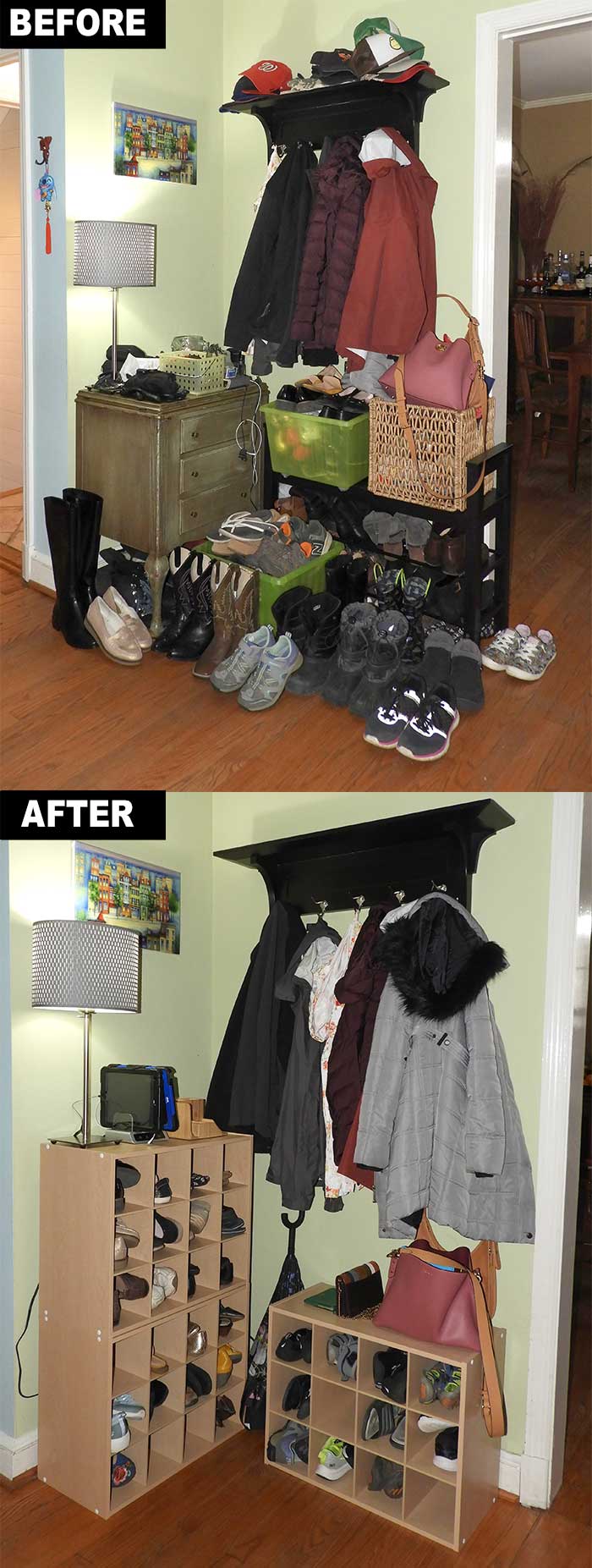Case Study #4: The Cluttered Foyer
Last updated May 2022
Our house was built in the 1930s. We love its architectural style and solid construction but have one major complaint: lack of storage space. It was noticeable right behind our front door, where guests were greeted by piles of shoes, coats, backpacks, and more that crowded our living room and spilled across the floor. There’s a small closet nearby but, instead of holding coats, it also had become an overcrowded catchall storage area.
Over the years, we’ve tried different ways to organize our entry area. We added shoe racks, wall hooks, and storage cubes. Corralling our two kids’ stuff wasn’t too difficult when they were little, but as they grew up their jackets, shoes, and backpacks got bigger—and so did our storage crisis. The storage cubes we were using hid our shoes instead of making them accessible; the hooks were too overloaded to hold guests’ coats.
I’d occasionally search for new storage solutions online or at stores to tame our front room. But I was overwhelmed by options and feared buying more organizing stuff would just add another layer to the mess.
I eventually decided we needed expert advice. I searched NAPO’s online directory and checked out nearby pros and found Vera, who had over 20 years of experience. On her website, she said she specialized in closets and clutter control. Bingo!
After contacting “Vera” and receiving a friendly response the same day, we exchanged a few emails. I told her about my issues and included a few photos of our front room and closet. She outlined how much she charged ($100 per hour, plus materials at cost), and we scheduled an appointment. Vera normally schedules an initial complimentary one-hour consultation, but after I sent photos we decided to do the consultation and start work on the same day.
During the appointment, we began by reviewing the foyer and closet, and talking about my goals: organizing the space; purging some items; and putting other less-used stuff in a different place. We then got to work—sorting coats, purses, reusable grocery bags, and other items. We separated the closet contents into four categories: keep; donate; throw out; and relocate.
After our big sort, Vera and I had significantly shrunk the number of things that would return to the closet. It was amazing how many little-used things living in this prime location could move to other places, such as the basement (namely a ton of reusable bags we had for some reason squirreled away). We also put lots of stuff into a donate pile, clearing up even more critical closet space.
 With the closet sorting done, we turned our attention to the collection of shoes on overflowing shelves and in bins, plus covering a large swath of the foyer floor. Vera suggested storing some of our footwear upstairs in bedroom closets or in the basement. But I explained that we always put on and remove our shoes near the door, and I really wanted to find a way to accommodate all our footwear in that area.
With the closet sorting done, we turned our attention to the collection of shoes on overflowing shelves and in bins, plus covering a large swath of the foyer floor. Vera suggested storing some of our footwear upstairs in bedroom closets or in the basement. But I explained that we always put on and remove our shoes near the door, and I really wanted to find a way to accommodate all our footwear in that area.
Vera asked me if the furniture in the foyer, including an antique sewing table with no storage, had to stay. Her questions and suggestions helped me look at our space in a new way: I realized that the table, while cool-looking, couldn’t hold anything, so we moved it into the living room.
After Vera’s first visit, which lasted about three hours, we scheduled another one. Shortly after, she emailed me links to a few new storage item options, including shoe cubbies and a special system for baseball cap storage. She purchased the items we needed and brought them to our next session, which we began with more sorting, this time tackling our shoe bins and piles by the door. I unearthed sneakers and boots that were too small for my kids and several pairs of mine I’d forgotten I owned. We found at least 10 pairs to donate or throw out, then separated seldom-worn footwear (snow, rain, and hiking boots) from those we wore more often. Less-frequently worn shoes went onto a new two-tier rack in our freshly organized coat closet; others went into new shoe organizers.
After two three-hour sessions with Vera—and spending about $1,000—I now have an uncluttered entry area. The shoe organizers keep the floor clear, and the space looks tidy. Our once-jammed closet now has extra storage, and items are more easily found.
Lessons Learned:
- Even small spaces can be organized into effective storage areas.
- Reserve prime locations for the items you use the most. Things you use only occasionally shouldn’t take up your most valuable spaces.
- Out of sight equals out of mind—I had packed things so tightly into the closet or bins that I didn’t know what we had anymore and couldn’t find things I needed. It’s better to keep visible the stuff you use often.
- Professional organizers aren’t miracle workers. You have to pitch in and be willing to make decisions.
- Working with an organizer taught me how to tackle similar projects to improve clutter throughout our house.


